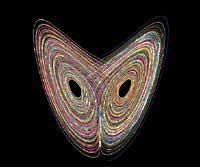Butterflies and chaos
2008/04/30 Carton Virto, Eider - Elhuyar Zientzia

Edward Lorenz (Photo: http://en.wikipedia.org/
wiki/Edward_Lorenz)
This knowledge is due to meteorologist and mathematician Edward Lorenz, who died a couple of weeks ago. In fact, in the 1960s, Lorenz realized that he was trying to invent how to predict time, as often happens in science, by chance. In fact, in the computer simulation developed by him he wanted to see a result again and, to make things faster, he introduced a data manually, but with a small change: instead of using the six decimals of the number as in the model, he put three, that is, he wrote .506 instead of .506127. The difference seems to be null, but the result obtained had nothing to do with the previous one.
Systems that function as time are called non-linear dynamic systems and are characterized by their dependence on the initial conditions of system evolution. At present these types of systems are studied within the theory of chaos and are numerous in both nature and technology. Chaos is present in the evolution of natural populations, heart beats, chemical reactions, electrical circuits, fluid dynamics, movement of star groups. And chaos, although its name may suggest otherwise, has a concrete form and structure of functioning. It is not random. On the contrary, the full name of chaos is deterministic chaos, as the initial conditions totally determine the evolution of chaotic systems. Another thing is that humans are able to predict that evolution.
Mathematicians are working on it. Chaos mathematics has been developed especially in the last forty years, becoming a powerful research tool. Powerful and conceptually revolutionary. In fact, if we turn to bibliography, chaos refers to XX. Which forms the trio of the most important contributions of the twentieth century, with quantum and relativity, because the three changed the way we look at nature.

Lorenz's contribution has been known as the butterfly effect, by the title of a paper he presented in 1972 on what was seen in the computer model: Does de flap of a butterfly's wings in Brazil set off a Tornado in Texas? (Does a butterfly strike the wings of Brazil cause a tornado in Texas? ). The title was not put by Lorenz himself, but by meteorologist Philip Merilees who coordinated the presentations, and it is not clear where the idea of the butterfly came from. Some claim that it is due to the story A sound of thunder by Ray Bradbury, science fiction writer (1952). In this story, Bradbury narrated how the death of a prehistoric butterfly influenced the election of the President of the United States. Merilees has denied this origin, but seeing how the Bardbury butterflies influenced the future of science fiction and Lorenz butterflies in science, it wouldn't be wrong.
Published in Berria

Gai honi buruzko eduki gehiago
Elhuyarrek garatutako teknologia




